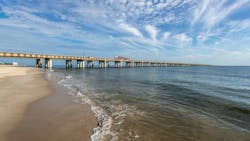Research: improvements to Chesapeake Bay may be more difficult
Researchers have found that, after a certain threshold of nutrient reductions, the Chesapeake Bay may require twice as much effort to respond to nutrient load changes, according to a press release from the University of Maryland’s Center for Environmental Science.
A new look at the history of water quality in the Chesapeake Bay shed light on how the estuary has responded to nutrient reduction efforts and why improvements have remained a major challenge. Researchers with the University of Maryland’s Center for Environmental Science looked at the Bay’s historic response to efforts to reduce nutrients to minimize dead zones and found there is a pollution threshold after which it takes twice the effort to make a change.
“Once nutrient pollution crosses a threshold and the system enters a eutrophic state, it will take much larger reduction to return to the original state,” said study co-author Ming Li, a professor at the University of Maryland Center for Environmental Science.
The bay’s low-oxygen zones, also called dead zones, are caused by excess nutrient pollution, primarily from agriculture and wastewater. Expanding dead zones over the decades have been linked to increased nutrient pollution, but this paper reveals that the system only responds to reductions until the amount of pollution crosses a certain threshold, then it takes twice the effort to see a change.
“As a result, the Chesapeake Bay has become recalcitrant to changes in nutrient loads, and larger reductions would be required to induce a complete reversal of eutrophication-induced hypoxia,” said Li. “This may partly explain the modest reduction in Chesapeake Bay hypoxia since the implementation of nutrient management strategies in the mid-1980s.”
This study examined the expansion of low-oxygen zones from 1950–1989, when the amount of nitrogen pollution in the Chesapeake Bay doubled. Previous analysis showed that the large expansion of hypoxia between 1950s and 1980s was correlated to increased nutrient pollution from rivers.
Hypoxia results from a complex interplay of various physical and biogeochemical processes. The degradation of habitats on the bottom of the Bay, such as underwater grasses and oysters, may have changed the estuary's capacity to filter nutrients and sediment. The impacts of climate change since 1989, such as warming, sea level rise, and changing precipitation patterns and river flows, together with associated changes in nutrient runoffs, may alter key baselines impacting the functioning of coastal systems and their responses to eutrophication.
“Looking into the future, nutrient reduction strategies will need to be considered in the face of accelerated warming and sea level rise in the 21st century,” said Li.
The research paper, “What drove the nonlinear hypoxia response to nutrient loading in Chesapeake Bay during the 20th century?” was published in Science of the Total Environment by Wenfei Li and Ming Li of the University of Maryland Center for Environmental Science.


